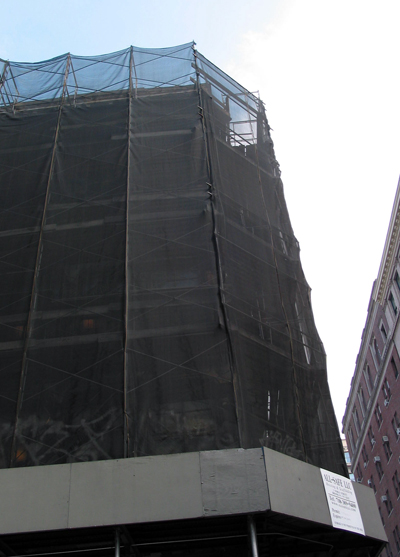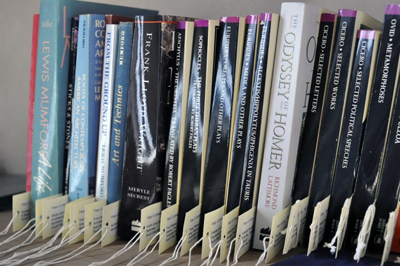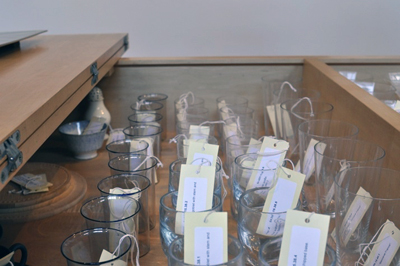Last month I took a break from Marfa and traveled to New York to volunteer for a week at 101 Spring Street. The Judd Foundation recently finished de-installing Donald Judd’s former residence in preparation for a three-year, $25 million renovation project.
This historic building, located on the corner of Spring and Mercer streets, is literally falling apart. Scaffolding obscures 101 Spring Street’s cast-iron exterior, but it’s not there for construction purposes. It was built as a protective measure eight years ago, when chunks of the façade began falling onto the sidewalk below.
The only remaining single-use cast-iron building in SoHo, 101 Spring Street dates from 1870. Judd bought the property for $68,000 in 1968, back when artists began inhabiting the neighborhood, attracted to its live-work loft spaces. He transformed it into a living studio and display place and designated each of its five floors and two basement levels for a specific activity, such as sleeping, artmaking or eating. Judd lined the walls with his personal collection of artwork by friends including Dan Flavin, Frank Stella and Claes Oldenburg. With his will, Judd established a foundation responsible for the care of this building and the objects he left inside following his death in 1994.
“The Foundation’s mission is to preserve and maintain Judd’s spaces,” explains Judd Foundation Director Barbara Hunt McLanahan. “Ultimately our goal is to provide access to those spaces.”
In 2008, the Judd Foundation took a step toward that goal by switching from a private to a public foundation. As such, the institution has to ensure its facilities meet government-mandated standards.
“We can’t allow members of the public in the building as it currently stands,” McLanahan says.
The renovation project will stabilize and repair the structure as well as bring the building up to code. Electrical and HVAC systems will be updated or added, and the two basement levels will be transformed into office, research and meeting spaces for the foundation.
101 Spring Street is part of the National Trust of Historic Preservation’s Historic Artists’ Homes and Studios program. Judd considered his treatment of the space as a precedent for the permanent installations he developed at the Chinati Foundation and the Mansana de Chinati, his residence in Marfa. “Everything from the first was intended to be thoroughly considered and to be permanent…” he wrote in his essay “101 Spring Street.”
When Judd said permanent, he meant it. The foundation’s staff takes great care to ensure that each item stays exactly where the artist left it.
“Judd took such care into placing things. We would never want to disrespect that,” says Michele Saliola, Judd Foundation development officer and project manager for the de-installation.
Imagine packing your own stuff up for a move, but having to make sure that all your belongings are put back in the exact same spot in three years. That’s precisely what Saliola and the team of Judd Foundation staff and volunteers dealt with during the de-install.
“We are taking the entire building apart and in three years time we will be putting the entire building back together—just like one big puzzle,” she says.
The first step was to conduct an inventory—of everything.
“We started inventorying every object in the building—from paper clips found in drawers and notes Judd had written inside books, to John Chamberlain sculptures,” Saliola explains. “We indentified them, photographed them for the first time, and came up with a plan for what to do with them.”
Conservators examined each object, determined what should be cleaned or repaired, and recommended how to safely store each item until 2013.
For me, one of the highlights was watching conservators roll a Frank Stella painting from 1968, which Judd had installed on the wall of the fourth floor, his formal dining area. After carefully removing the canvas from its stretcher and lying it on top of plastic sheeting, the conservation staff painstaking rolled the canvas into a tight tube—the edges had to line up exactly to prevent creasing.
I helped out primarily with Judd’s bedroom closet and kitchen. The artist had an affinity for meat slicers and Brooks Brothers suits.
Each object–a Stella painting, a juice glass, a fur coat–had a tag with a corresponding inventory number. The tags were attached to and packed up with each item. Labels corresponding to each tag were stuck to sheets of paper taped to the outside of each crate or box, clearly marking its contents. All the while, staff and volunteers maintained big binders with master inventory lists for each floor. Occasionally, new, non-inventoried items popped up, such as the broken razor and a used bar of soap discovered underneath one of Judd’s claw-foot bathtubs.
Already a complex undertaking, the de-installation was further complicated by the fact that everything had to be packed and moved out of the building in just 15 days.
While planning the project, Saliola consulted colleagues at other historic houses for advice.
“That may have worked for them when they had six months, but we had a matter of days,” she says. “We had to be realistic and practical about what was going to work.”
So far, so good. Everything that needed to be out of the building has been removed. Construction begins this fall. But the test will come with reinstallation in 2013.
“You’ll know we’ve done a good job if you come back and everything is the same,” McClanahan says.







